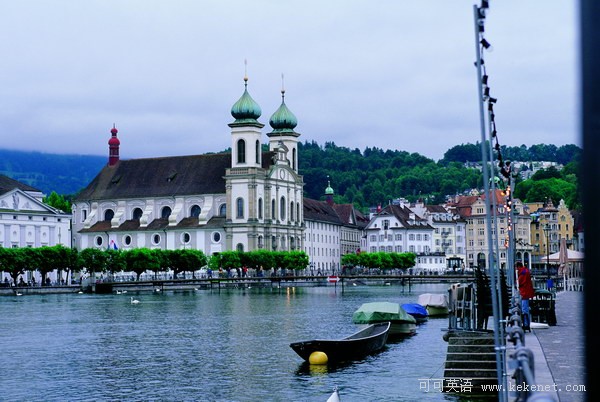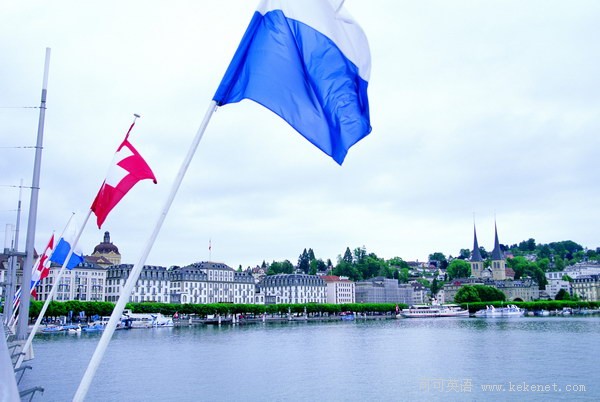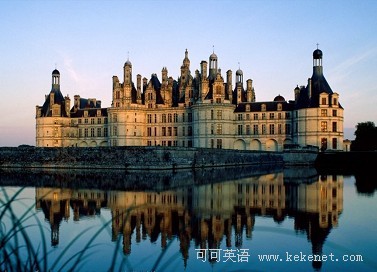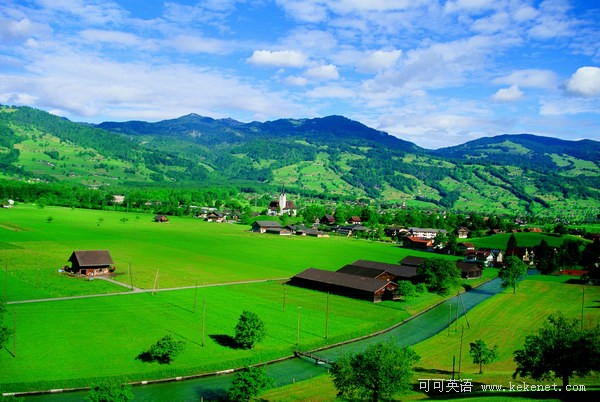(单词翻译:单击)
在最新公布的全球生活质量最佳城市排行中,瑞士的苏黎世、日内瓦和伯尔尼分列前十名中的第一名、第二和第五名。世人于是惊呼,小小的瑞士真的是“人间天堂”。


A country of west-central Europe. The region was conquered by Germanic tribes in the 5th century and by Swabia and Burgundy in the 9th, becoming part of the Holy Roman Empire in 1033. Protesting Hapsburg control in the 13th century, the Swiss formed a defense league made up of cantons that became the basis of their confederation, and by 1499 they had achieved independence. The Reformation in the 16th century led to religious civil wars that lasted through the next two centuries. The French took brief control of Switzerland during the French Revolution, but the confederacy was restored in 1815. Switzerland later adopted a federal constitution (1848) and maintained a policy of neutrality through both World Wars. Bern is the capital and Zurich the largest city. Population: 7,550,000.
瑞士是位于欧洲中南部的多山内陆国。东界奥地利、列支敦士登,南邻意大利,西接法国,北连德国。其领土东起东经10°29'26"格劳宾登州的沙瓦拉茨峰,西至东经5°57'24"的日内瓦的尚希镇,最南端位于北纬45°49'8",靠近提契诺州的基亚索,最北面在北纬47°48'35",系沙夫豪森州的巴尔根。南北长220.1公里,东西长348.4公里。

Country, central Europe. Area: 15,940 sq mi (41,284 sq km). Population (2005 est.): 7,519,000. Capitals: Bern (administrative), Lausanne (judicial). The population is German, French, and Italian. Languages: German, French, Italian, Romansh (all official, with Romansh used locally). Religions: Christianity (Roman Catholic, Protestant); also Islam. Currency: Swiss franc. Switzerland is divided into three regions: the meadow-covered Jura Mountains; the central Mittelland, a rich agricultural and urbanized area; and the lofty crags of the Alps. It is one of the world's major financial centres; its economy is based largely on international trade and banking, as well as light and heavy industries. Manufactures include watches, precision instruments, machinery, and chemicals. Tourism and agriculture are also important; products include grains, sugar beets, fruits and vegetables, dairy products, chocolate, and wine. Despite diverse ethnic groups, religions, and languages, Switzerland has maintained the world's oldest democracy for some 700 years. It is a federal state with two legislative houses; its head of state and government is the president of the federal council. The original inhabitants were the Helvetians, who were conquered by the Romans in the 1st century BC. Germanic tribes penetrated the region from the 3rd to the 6th century AD, and Muslim and Magyar raiders ventured in during the 10th century. It came under the rule of the Franks in the 9th century and the medieval empire (later the Holy Roman Empire) in the 11th century. In 1291 three cantons formed an anti-Habsburg league that became the nucleus of the Swiss Confederation. It was a centre of the Reformation, which divided the confederation and led to a period of political and religious conflict. The French organized Switzerland as the Helvetic Republic in 1798. In 1815 the Congress of Vienna recognized Swiss independence and guaranteed its neutrality. A new federal state was formed in 1848 with Bern as the capital. Switzerland remained neutral in both World War I and World War II and has continued to defend this neutrality. It joined the European Free Trade Association in 1960, but it has opted against joining the European Union. It joined the United Nations in 2002.
全境分中南部的阿尔卑斯山脉(占总面积的60%)、西北部的汝拉山脉(占10%)、中部高原(占30%)三个自然地形区。平均海拔约1350米,最高点是接近意大利的杜富尔峰(DUFOUR-PEAK,海拔4634米),最低点是位于提契诺州的马祖尔湖(LAKE MAGGIORE,海拔193米)。瑞士是一个山国,山清水秀。其森林面积达12523平方公里,占全国面积的30.3%。如果再加上农业、绿地面积(10166平方公里,占全国面积24.6%),则全国一半以上的土地被绿地所覆盖。

Between the Jura and the Central Alps, which occupy the southern section (more than half) of the country, there is a long, relatively narrow plateau, crossed by the Aare River and containing the lakes of Neuchâtel and Zürich. Alpine communications are assured by numerous passes and by railroad tunnels, notably those of Lötschberg, St. Gotthard, and Simplon. Switzerland consists of 26 federated states, of which 20 are called cantons and 6 are called half cantons. The cantons are Zürich, Bern, Lucerne, Uri, Schwyz, Glarus, Zug, Fribourg, Solothurn, Schaffhausen, Saint Gall, the Grisons (Graubünden), Aargau, Thurgau, Ticino, Vaud, Valais, Neuchâtel, Geneva, and Jura. Of the half cantons, Obwalden and Nidwalden together form Unterwalden, Basel-Land and Basel-Stadt form Basel, and Ausser-Rhoden and Inner-Rhoden form Appenzell.
瑞士是欧洲大陆三大河流发源地,有“欧洲水塔”之称。主要河流有:莱茵河(在瑞士境内375公里,是瑞士最大的河流)、阿尔河(在瑞士境内295公里,是瑞士最长的内陆河)、罗纳河(在瑞士境内264公里,是瑞士第二大内陆河)。湖泊共有1484个,其中最大的是莱蒙湖(又名日内瓦湖),面积582平方公里,最深处310米,其它有:康斯坦茨湖、纽沙泰尔湖、马乔雷湖、四州湖、苏黎世湖等。瑞士的河湖面积达1726平方公里,占瑞士全国面积的4.2%。
(莱茵河)
瑞士地处北温带,地域虽小,但各地气候差异很大。阿尔卑斯山由东向西伸展,形成了瑞士气候的分界线。阿尔卑斯山以北受温和潮湿的西欧海洋性气候和冬寒夏热的东欧大陆性气候的交替影响,变化较大;阿尔卑斯山以南则属地中海气候,全年气候宜人。瑞士年降雨量为1500毫米,但各地分布不均。年平均气温为8.6摄氏度。在城市中,夏季气温可达华氏86度(摄氏30度),空气湿度适宜;冬季气温经常低于华氏32度(摄氏0度),时有下雪结冰的现象。


